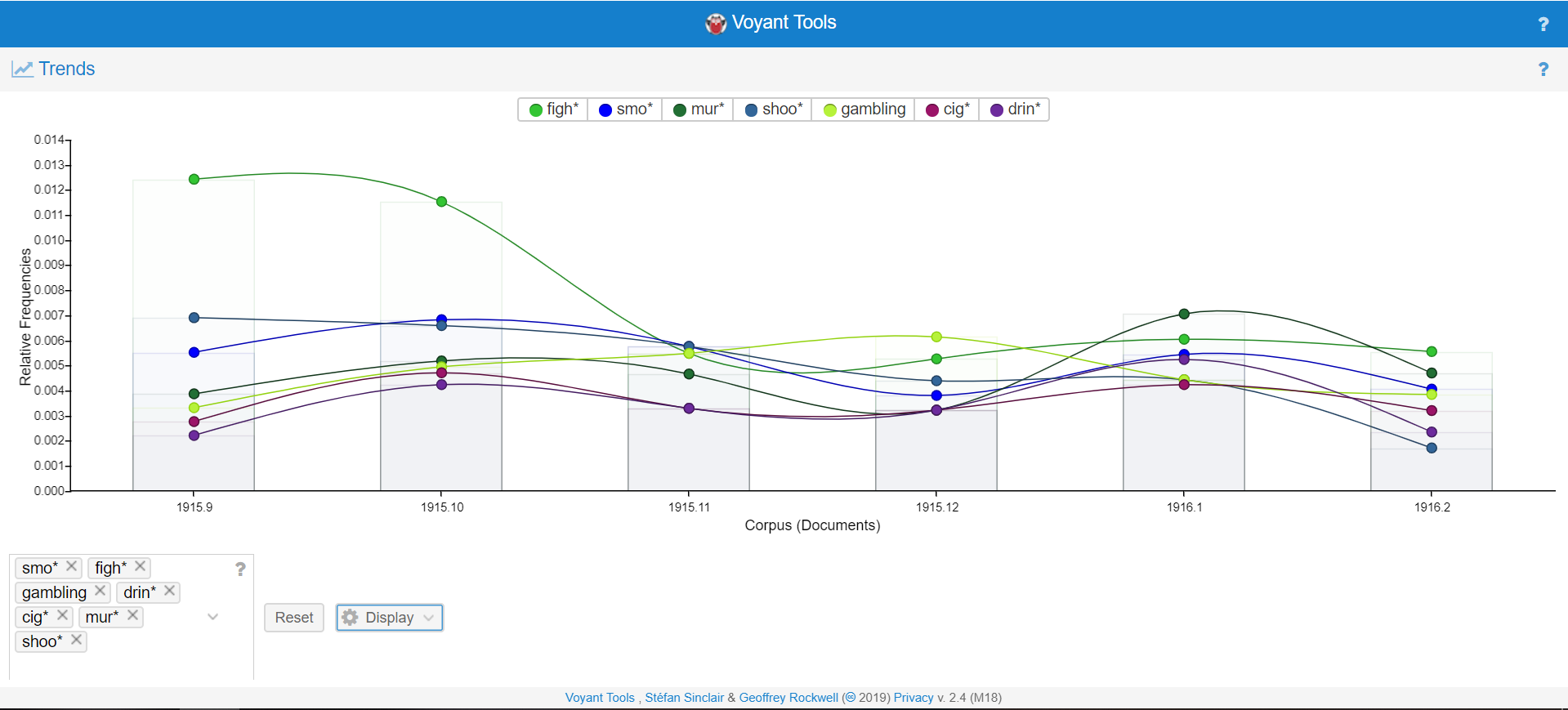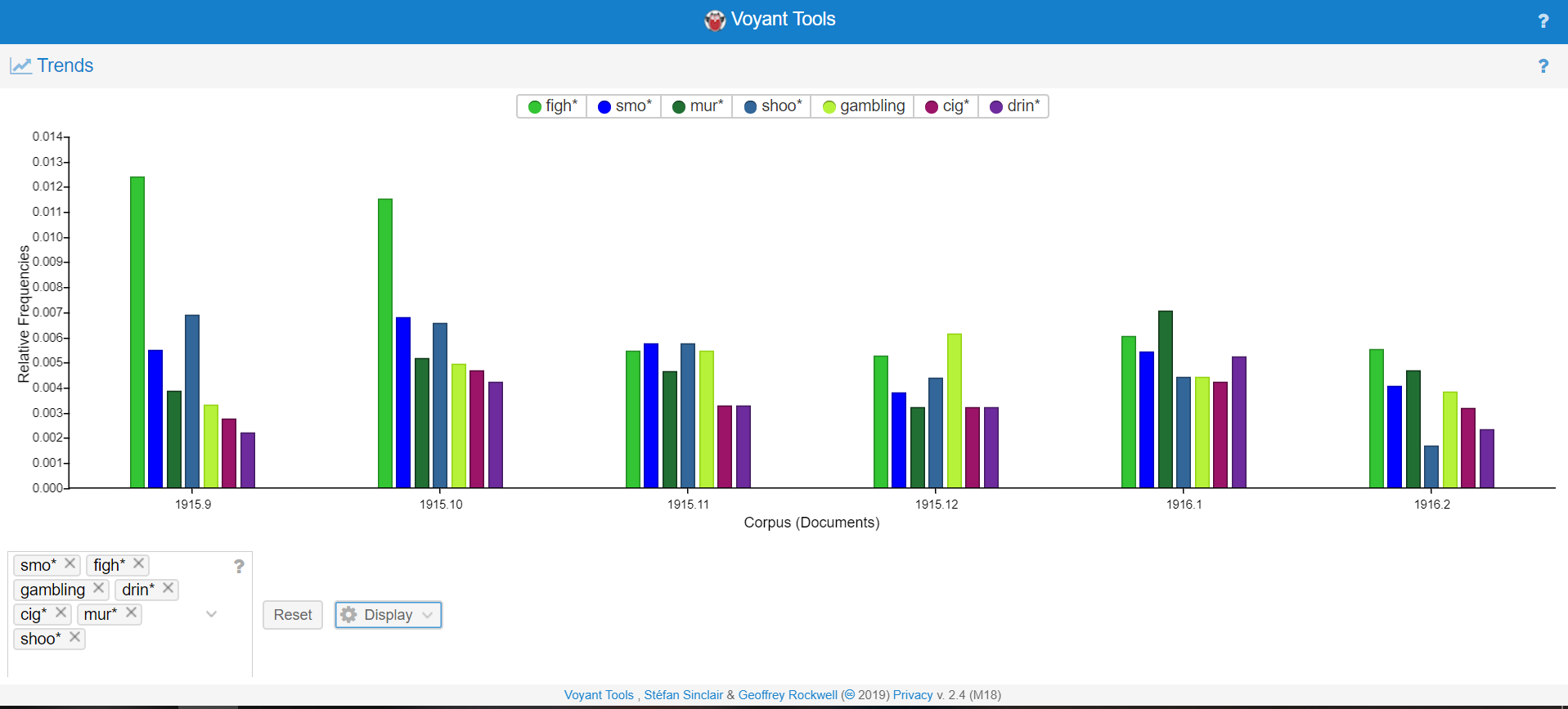Censorship Topics
The two main questions driving the text analysis of the Bulletins are: what are the main topics of censorship and how did gender play a role in those topics? In order to identify the various major topics of censorship, the Bulletin corpus was uploaded into Voyant. This corpus was analyzed using a select number of Voyant tools (follow the link to read more about each tool): Summary, Cirrus (more commonly referred to as Word Cloud), and Trends. For the research question of how gender played a role in the topics of censorship, the corpus was analyzed with the Collocates and Contexts tools. All of these tools are embedded below, though they make take a moment to load. If they do not load, a link to an image of the tool can be found in the description below the embedded tool. Additionally all of the images are available on the About page.
Summary
The Summary tool gives an overview of the entire corpus. The six documents are each a month of eliminations, the Bulletin weeks were combined into months to make the corpus more managable. As you can see in the embedded tool above, the Summary tool provides basic information such as length, vocabulary density, and average words per sentence that does not apply to this corpus do to the nature of the documents (for further information see the Text Analysis page. But the interesting aspect of the summary tool for this research is the most frequent words and distinctive words. The "most frequent words" shows at glance some of the major terms that the censors used repeatedly in the eliminations, note that the top four are gender terms. This will be examined further in the Word Cloud and Collocates tools below. The "distinctive words" shows terms that were unique to that month of eliminations, such as Chaplin, wedding, and gasoline. It might surprise you to find that the term "plot" is distinctive, but the censors rarely mentioned plot in their eliminations. Their focus was only upon the actions that should be removed from the films and they generally refrained from commenting on the larger themes of a film.
Word Cloud
The Word Cloud is one of the most commonly used text analysis tools, but that does not mean it is any less effective. As you may know, the size of the word denotes the number of times it occurs in the corpus, and hovering over the word reveals the specific count. There is no meaning to the colors, location, or position of the words. As was seen previously in the Summary tool, gender terms make up the first four commonly used term, with "man" appearing more than twice any other term. But what is important to note for this section of the analysis is what verbs appear that can reveal the major topics of censorship: Fight (137), Gambling (114), Smoking (99), Shooting (99), Murder (98), and Drinking (62). By uploading the corpus into Voyant, the Word Cloud tool has made it simple to identify the major topics of censorship. Note that with the exception of "fighting" and "drinking", most of the words appear within the same frequency, something that we can track with the Trends tool below.
Trends


Unfortunately when the Trends tool is embedded into the page it loses the searched terms, and to fix that two screenshots of the Trends tool with the censorship topics identified by the Word Cloud have also been included. Notice that each word has an asterisk on it, that is to account for any permutations of the verb: figh*= fight, fights, fighting. The censors always wrote the eliminations in present tense, so there is no need to search for "fought" or any other past tense forms of the verbs. Using the Trends tool, especially the columns display, reveals that fighting is consistently a major theme in censorship, particularly in September and October 1915. Surprisingly, drinking is not a major theme of the censorship, comparatively. Additionally, the word cig* (cigar, cigarette) is included to show that action of "smoking" was more commonly referenced than the item being smoked. The censors were more concerned with the actions occurring on screen than the objects, plot, or themes present in the film.
Gender
Now that the major topics of censorship in 1915-1916 have been identified as a series of actions: fighting, gambling, smoking, shooting, murder, and drinking; the focus of the research shifts to how those topics relate to gender. As noted previously, the Voyant Collocates and Contexts tools are utilized for this research.
Collocates
The Collocates tool shows the proximity of terms as they appear to one another in the corpus. For example, the first row shows that the terms "man" and "woman" appear close to one another 140 times in the corpus. Examining the information presented in this tool shows us that more often than anything else, the gendered terms appeared close to another in the requested eliminations from the film. That is surprising, for given the censorship topics shown above one would have guessed that "man/men" and "fighting" or "man/men" and "shooting" would have ranked the highest in appearing in proximity. But rather it is "man" and "woman." This raises the possibility that one of the censor's chief goals was to regulate the relations of men and women as they appeared on the screen. This sort of claim needs further research, but the connection is clearly indicated here. But there is a stronger claim that can be made based on the information presented in this tool. After the first five rows of gender terms, the next series of terms that appear in proximity are "women/girl" and "smoking/cigarette." Note that "man/men" does not appear anywhere in proximity to "smoking/cigarette." Is it possible that smoking was only censored when women were doing it? And is there then a direct relationship between a topic being censored and the gender performing it? To answer this question look to the contexts tool.
Contexts
The Contexts tool allows you to search for a single term and the tool will show where that term appears across the entire corpus, and what comes before and after that term. The embedded tool above is already set to search for the term "smoking," in order for us to answer the question of the relationship between that censored topic and gender, as posed in our analysis of the Collocates tool. The tool can be adjusted to reveal more of the left or right as necessary. If you scroll down through all the instances of word smoking, you will see that two times in 1916.1 it appears as "men and women/girls" smoking. But only one time, in the entire corpus, is a man censored for smoking (1916.1). And then, in that instance, he is smoking an "opium pipe." A man is never censored for smoking a cigarette or a cigar, only women. Further, in the Example Films section, I examine the 1915 Charlie Chaplin film Shanghaied, of which the censors had several eliminations requested. In that film Charlie Chaplin does smoke a cigarette and there is no elimination of it requested. Thus, we can safely claim that the censorship topic of smoking was directly linked to the gender that was committing the action.
Conclusion
By uploading the corpus of September 1915 - February 1916 Bulletins into Voyant and using their text analysis tools, the major topics of censorship, as stated in the eliminations, were able to be identified as: Fighting, Gambling, Smoking, Shooting, Murder, and Drinking. The analysis confirmed that the censors focused upon actions, rather than ideas such as plot and theme. This analysis will be carried out further in the Elimination Charts page, a close reading of the Bulletins to explore the broader categories of censorship, such as violence, death, and animals. Further, by examining the proximity and contexts of the terms used, it was shown that the censorship topic of smoking was directly connected to the gender that was performing the action, and thus it can be claimed that gender did a play a role in the Board's censorship in 1915-1916.